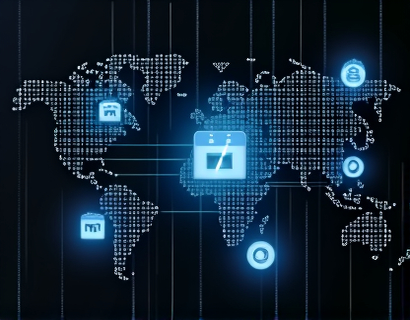Blockchain-Driven Asset Tokenization: Transforming Real-World Assets for Enhanced Market Accessibility and Liquidity
Blockchain technology is at the forefront of a revolutionary shift in asset management, offering a novel approach to integrating real-world assets into the digital realm. This transformation is not merely a technological advancement but a paradigm shift that promises to enhance liquidity, market accessibility, and overall efficiency in asset transactions. By tokenizing physical assets on the blockchain, individuals and businesses can tap into new opportunities, streamline processes, and secure transactions in a transparent and trustworthy environment.
The concept of asset tokenization involves converting tangible assets such as real estate, art, infrastructure, and even intangible assets like intellectual property into digital tokens. These tokens represent fractional ownership or rights to the underlying asset, enabling a more democratized and liquid market. The integration of blockchain technology ensures that these tokens are secure, immutable, and easily tradable, thus addressing some of the most significant challenges in traditional asset management.
Enhancing Liquidity through Tokenization
One of the primary benefits of blockchain-driven asset tokenization is the enhancement of liquidity. Traditional assets are often illiquid, meaning they take a long time to buy or sell, and the process can be cumbersome and expensive. Tokenization changes this dynamic by allowing assets to be divided into smaller, tradable units. This fractional ownership model makes it easier for investors to enter and exit positions, thereby increasing the overall liquidity of the market.
For instance, a piece of real estate valued at millions of dollars can be tokenized into thousands of smaller shares, each representing a fraction of the property. This allows a broader range of investors, including those with smaller capital, to participate in the market. The ability to buy, sell, and trade these tokens on decentralized exchanges further facilitates liquidity, as transactions can occur 24/7 without the need for intermediaries.
Improving Market Accessibility
Accessibility is another critical aspect where blockchain-driven asset tokenization shines. Traditional asset markets are often dominated by institutional investors and high-net-worth individuals due to the high entry barriers and complex regulatory environments. Tokenization democratizes access by lowering these barriers. Smaller investors can now participate in markets that were previously out of reach, fostering a more inclusive and diverse investor base.
Moreover, the global nature of blockchain technology means that assets can be accessed and traded from anywhere in the world, breaking down geographical barriers. This global reach not only increases the potential investor pool but also enhances market efficiency by bringing together buyers and sellers from different regions, thus improving price discovery and reducing information asymmetry.
Ensuring Security and Transparency
Security and transparency are foundational to the blockchain ecosystem, and asset tokenization leverages these attributes to create a more trustworthy environment. The immutable nature of blockchain ensures that once a transaction is recorded, it cannot be altered or deleted. This immutability reduces the risk of fraud and manipulation, providing investors with greater confidence in the system.
Smart contracts, self-executing contracts with the terms directly written into code, play a crucial role in this process. They automate and enforce the terms of the transaction, ensuring that all parties adhere to the agreed-upon conditions. This reduces the need for intermediaries, lowering transaction costs and speeding up the process. Additionally, the transparency of the blockchain ledger allows all participants to verify transactions and asset ownership in real-time, further enhancing trust and accountability.
Use Cases and Industries Impacted
The applications of blockchain-driven asset tokenization are vast and varied, impacting multiple industries and use cases. In the real estate sector, tokenization can simplify property investments, enable fractional ownership, and facilitate cross-border transactions. For example, a commercial building can be tokenized, allowing investors to purchase shares of the property and earn rental income or capital gains without the need for direct ownership.
In the art world, tokenization can address issues of authenticity and provenance. Digital tokens can represent ownership of art pieces, ensuring that the history and ownership details are transparently recorded on the blockchain. This not only enhances the value of the art but also provides collectors with a secure and verifiable way to own and trade artworks.
The infrastructure sector can also benefit significantly from asset tokenization. Large infrastructure projects often require substantial capital investment and long-term returns. By tokenizing these assets, smaller investors can contribute to the funding, and the returns can be distributed more equitably among the token holders. This model can accelerate the development of critical infrastructure while providing a new revenue stream for investors.
Challenges and Considerations
Despite the numerous benefits, the path to widespread adoption of blockchain-driven asset tokenization is not without challenges. Regulatory uncertainty remains a significant hurdle, as different jurisdictions have varying approaches to blockchain and tokenized assets. Compliance with securities laws, anti-money laundering regulations, and other financial regulations is essential to ensure the legitimacy and sustainability of tokenization projects.
Technical challenges also need to be addressed, such as scalability and interoperability. As the number of tokens and transactions grows, blockchain networks must be able to handle the load efficiently. Additionally, different blockchain platforms need to work together seamlessly to facilitate cross-chain transactions and maximize the benefits of tokenization.
Another consideration is the education and awareness of stakeholders. Both investors and asset managers need to understand the intricacies of blockchain technology and tokenization to fully leverage its potential. Providing comprehensive educational resources and support can help bridge this knowledge gap and foster broader adoption.
Future Prospects and Innovations
The future of blockchain-driven asset tokenization is promising, with ongoing innovations set to address current challenges and unlock new possibilities. Layer 2 solutions and cross-chain bridges are being developed to enhance scalability and interoperability, making tokenized assets more accessible and efficient to trade.
Furthermore, the integration of other blockchain technologies, such as decentralized finance (DeFi) and non-fungible tokens (NFTs), can create new hybrid models that combine the strengths of different blockchain applications. For example, tokenized real estate assets could be combined with DeFi protocols to offer lending and borrowing options, increasing the utility and value of these assets.
In the realm of sustainability, tokenization can play a role in financing green projects and promoting environmental, social, and governance (ESG) goals. By tokenizing sustainable infrastructure and renewable energy projects, investors can support eco-friendly initiatives while earning returns, aligning financial incentives with environmental objectives.
Conclusion
Blockchain-driven asset tokenization represents a transformative force in the world of asset management, offering enhanced liquidity, improved accessibility, and increased security and transparency. By breaking down traditional barriers and enabling fractional ownership, this technology opens up new opportunities for a broader range of investors and stakeholders. While challenges remain, the ongoing development and innovation in the blockchain space are paving the way for a more inclusive, efficient, and dynamic asset market. As more entities embrace this technology, the future of asset management looks brighter and more interconnected than ever before.










































